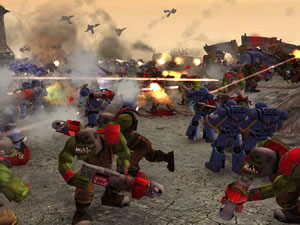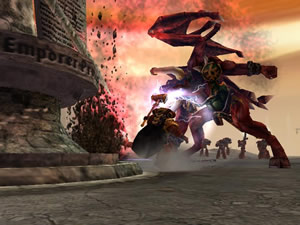This is what war is good for.
Humans love destruction. From little kids with baseball bats and G.I. Joes to rubber-neckers creeping down the freeway for a ghastly glimpse of road-side carnage, people everywhere have an affinity for the fruits of entropy. The most overt example of our fascination with the macabre is war, where soldiers from diverse nations meet on a field with one goal: violent victory.
Although some are disgusted by humanity’s appetite for devastation, others have realized that it is the stuff great games are made of. Just witness THQ’s new Warhammer
40,000: Dawn of War. Developed by Relic Entertainment, the minds behind RTS games like Homeworld and Impossible
Creatures, Dawn of War captures the fearsome attitude of the Warhammer 40,000 board
game while packing it full of visceral punch. Although Dawn
of War doesn’t introduce many significant mechanical innovations to the genre, it’s loaded with enough savage Warhammer style to quench our thirst for carnage.
The first dose of said style is administered via a lengthy, bloody cutscene that introduces the state of affairs between humans and Orks. Then you’re moved into Dawn
of War‘s sweet menu, complete with laser-eyed skulls and ubiquitous gameplay modes. Campaign, Skirmish, and Multiplayer hardly represent a new dawn in ways to play your strategy game, but fortunately Dawn
of War‘s proof is in its gory pudding.
In the single-player campaign, you control a platoon of Space Marines known as The Blood Ravens representing the genetically-engineered iron fist of the Galactic Emperor. Unfortunately, your empire is beset on all sides by vicious alien foes, while traitorous heretics plot its downfall from within your own borders. It is your charge to investigate these threats and replace them with smoldering craters.
The story begins as Force Commander Gabriel and his squad of Blood Ravens are
called down to a planet besieged by Ork forces. After driving back the unusually
organized Ork offensive, it becomes clear to Gabriel that some mysterious hand
is moving the Ork pawns as a distraction from what are surely fell deeds. Suspecting
that the culprits are the dreaded Chaos Space Marines, a rogue, demon-worshipping
cult, you investigate further only to be caught up in a planet-wide battle
between the Orks, the forces of Chaos, and the ancient Eldar, who have come
to thwart the vile schemes of the Chaos Space Marines.
Although Dawn of War‘s plot is entertaining for its over-the-top space drama and galaxy-threatening conspiracies, most of the effect is nullified by the total lack of pathos. Every race is motivated purely by xenophobia, power, and bloodlust. The Warhammer 40,000 mythos isn’t about stories or friendships; it’s about using spikes and fire to kill everything that moves. But while the plot may suffer from the aggro approach, the action benefits greatly.
Dawn of War skews more towards the quick, frantic play of Relic’s own Impossible Creatures than, say, Age of Empires. Regardless of which of the four races you choose to play, you will be competing against your foes for strategic points on the battlefield. Once captured, these will provide you with a constant stream of requisition resource, essentially money used to purchase everything from troops and structures to tech upgrades. Once you’ve captured a point, you can build a listening post on it and then upgrade the posts multiple times with weapons. Every listening post built enhances your requisition rate, as does every listening post upgrade. As a result, a player who is aggressive and captures as many strategic points as possible will not only control the battlefield, he will also control its resources.
 There are also vital objectives and slag deposits. The objectives are used to great affect on the various maps, as their number and location can drastically alter the way a match must be played. Relics, on the other hand, can be used by the Eldar and Chaos Space Marines to summon humongous, badass gods and demons that can easily turn an opponent’s formerly fortified stronghold into so many craters and corpses.
There are also vital objectives and slag deposits. The objectives are used to great affect on the various maps, as their number and location can drastically alter the way a match must be played. Relics, on the other hand, can be used by the Eldar and Chaos Space Marines to summon humongous, badass gods and demons that can easily turn an opponent’s formerly fortified stronghold into so many craters and corpses.
The slag deposits can be used to build large reactors, which are then used to harvest another resource: power. All buildings, vehicles, and many upgrades require power to run. A reactor built on a slag deposit provides power at triple the rate of another, making them hot little bits of real-estate, especially on larger maps where players have time to build mechanized forces.
Despite this breadth of resources, Dawn of War is not management
intensive. You do not build little grunts to mine caves or harvest oat or anything.
Slowly teching up or trying to play turtle and go defensive won’t succeed here
nearly as well as simply churning out units and storming the map like a lunatic.
That’s not to say that the game is without subtleties, however. Many Ork unit types, for instance, are only buildable if you have a certain number of units in play. The Squiggoth, an elephantine behemoth loaded with weapons that can carry two squads of troops, only becomes available once the Orks have 90 units in play.
This is just one example of the tactics Relic uses in Dawn
of War to force you
to play certain races certain ways, and is at the core of Dawn
of War‘s balance. Orks are the race of attrition, and their requirements and abilities reflect this. They inhabit one end of the spectrum with the Eldar occupying the other, while the Space Marines and Chaos Space Marines make up the middle ground.
 Every race shares some fundamental similarities, but Dawn
Every race shares some fundamental similarities, but Dawn
of War‘s main depth comes from its awesome, highly-customizable squad system. When a player orders marines, four emerge from the barracks as one squad. The squad is treated as one unit, and the individual members of the squad are beyond the player’s direct control.
Once you have a squad, there are a ton of neat things you can do with it. For example, squads can be reinforced with certain number of troops from anywhere on the battlefield. If a troop dies, the player can simply click the ‘reinforce’ button and after a short while, the dead troop will be replaced by a newbie. Commanding units for each squad offer various bonuses and you can customize any squad with a ton of upgrades. Whereas you started with a squad of four regular troops, within minutes that can be ten guys with a couple flamethrowers, some grenade launchers, and a commander leading the way.
Which comes in handy, as all troops are subject to morale. Certain weapons aren’t particularly damaging, but they burn away morale. When a squad’s morale goes, they scatter and incur heavy stat penalties. Squads can also be disrupted by artillery. If you launch an explosive into the middle of ten guys, they’ll all go flying, momentarily stunned. The morale and knock-back damage are just a couple of the cool details that make participating in Dawn
of War‘s battles fun and interesting to manage.
The single-player game, however, is not particularly well-designed. The harsh
linearity of the 12 level campaign limits the sense of chaos
and violence by forcing you to lead your troops through one hallway of a map
after the other. While there are some cool scripted bits and some interesting
details to be found in several levels, there’s never more than one way to accomplish
a given mission, and never any opportunity to choose one mission over the other.
For that matter, there’s only one campaign here – the Space Marines. If you want to kick ass as the other races, you’ll have to hop into skirmishes on or offline. Either way, you may play as any of the four races against up to seven other players. The game functions well as a multiplayer affair thanks to its up-tempo style, although a good deal of the strategy lies in figuring out which tactics work best for which maps.
 Unfortunately, Dawn of War suffers from some irritating path-finding issues.
Unfortunately, Dawn of War suffers from some irritating path-finding issues.
Moving troops around can be a pain because you’re always required to move them en-masse. What’s worse, though, is trying to position large vehicles. These things basically won’t move into any space that is remotely near another unit, making it difficult to order them around the map. For a strategy game, this can be a real buzz-kill.
You’ll get that buzz back pretty quickly, though, when you stare wide-eyed at the carnage offered by the fancy 3D engine. Dawn
of War is definitely one of the most impressive looking real-time strategy games around. The colors are vibrant, the blood prodigious and framerate generally smooth. A great zoom feature lets you see all sorts of nasty little nuances and death animations up close. The physics are great, adding oomph and flying corpses to a well-placed artillery strike. There are some stability issues – expect a few crashes here and there – but nothing too frustrating.
Dawn of War sounds like hell, but in a good way. The weapons sound great, battles are full of cries of anguish, and the voice-acting is very over-the-top and cool; you’ll definitely know who the bad guys are.
Dawn of War‘s tremendous unit design and the resulting balance
makes for some addictive, tactical gameplay. The limited campaign isn’t very
long, and, more importantly, isn’t very interesting, but crushing online foes
and battling the computer is a blast. While Dawn of War doesn’t
reinvent the RTS wheel, it does cover it with spikes and roll it over entire
armies of screaming victims. Bring down the hammer.







